Michigan is a unique and beautiful state with a wide variety of natural wonders. From its crystal-clear lakes to its rustic forests, there is so much biodiversity to discover in this great state. Among the most iconic and beloved of the state’s wildlife are the five official state animals of Michigan. Let’s take a closer look at each of these majestic creatures in detail and see why they are such important symbols for the state of Michigan.

Official State Animals in Michigan
Michigan has kept its collection of official state symbols notably strict. There have not been any new officially designated state symbols since 2002. Any proposed additions require approval from both the legislative process and the current governor. This careful selection process ensures that only those most deserving icons are recognized as symbols of the great state of Michigan.
Even though the likelihood of success is low, Michigan lawmakers, students, and engaged citizens push for new state symbols or changes to existing ones each year. For example, in 2013, the House introduced three different bills proposing different official state amphibians — the eastern gray tree frog (Dryophytes versicolor), Blanchard’s cricket frog (Acris blanchardi), and the northern spring peeper (Pseudacris crucifer). However, none of these were passed by the House Government Operations Committee.
So far, Michigan has designated 12 official state symbols, five of which are animals. Let’s take a closer look at the animals that successfully made it through this difficult process and are now recognized symbols of Michigan!
1. State Bird: American Robin (Turdus migratorius)
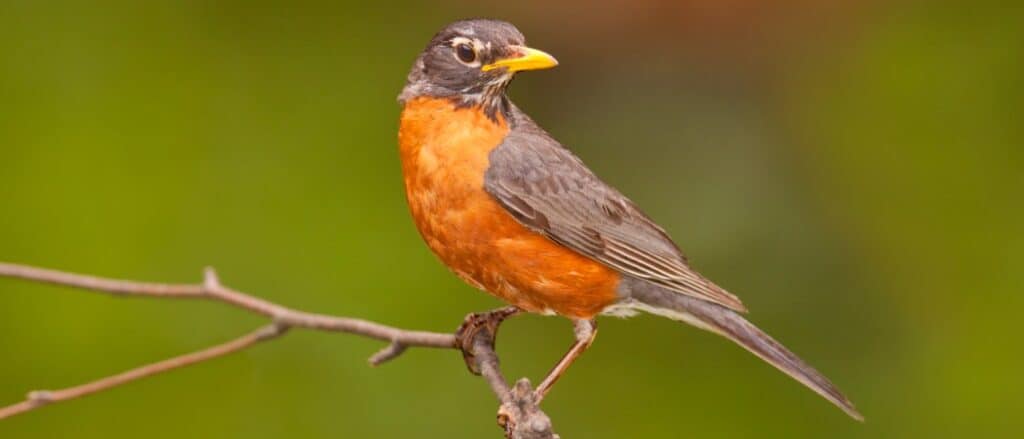
The American robin is one of the first birds that many in Michigan see once the winter is over.
©iStock.com/Silfox
The first official state animal of Michigan was the American robin (Turdus migratorius), designated in 1931 as the state bird. Two years earlier, the Michigan Audubon Society held a contest, with the final round pitting the American robin and the chickadee against each other. Ultimately, the robin received the most votes, but even today there is a good number of people who continue to lobby for the chickadee, as this bird stays in Michigan even during the state’s bitter winters.
However, the American robin is one of the first birds that many in Michigan see once the winter is over, and it is a sign of hope and springtime. Robins are one of the most widespread thrushes in North America and are extremely adaptable, living in forests and woodlands, as well as in backyards and parks. American robins can be seen all over Michigan, eating insects, worms, and berries. These small songbirds are easy to spot due to their reddish or rust-colored breast and white bellies. Female robins have more muted colors and lay beautiful blue eggs multiple times each year.
2. State Fish: Brook Trout (Salvelinus fontinalis)
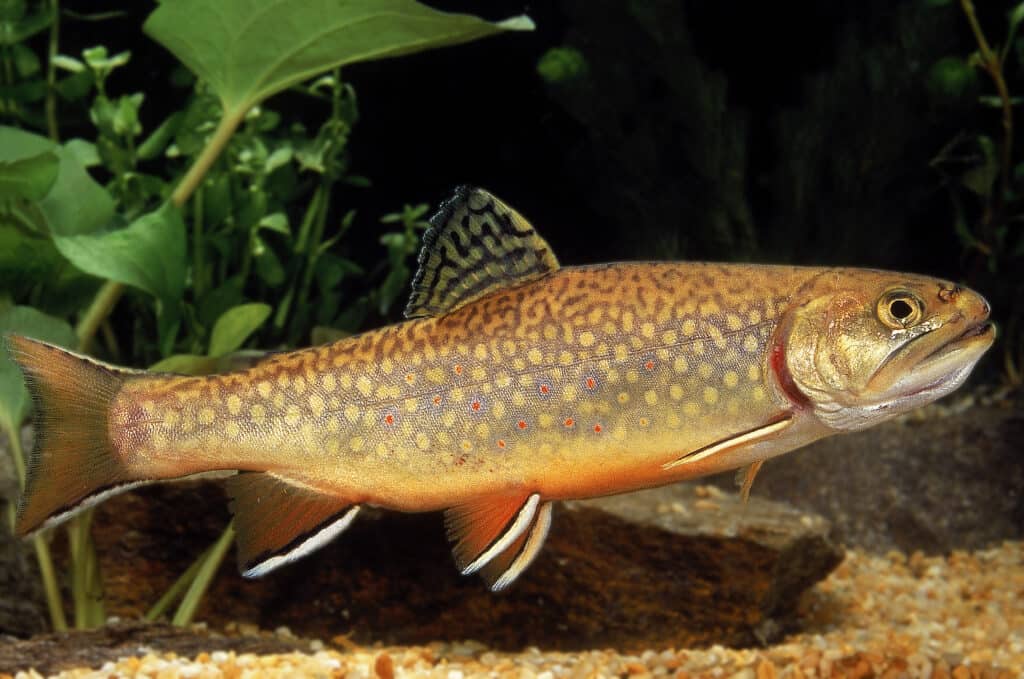
Brook trout are native to Michigan and can be found throughout the state in streams, lakes, and rivers with cool, clear water.
©Slowmotion GLI/Shutterstock.com
In 1965, the trout was designated as the official state fish of Michigan. For the next two decades, however, people debated exactly which trout species this referred to. So, in 1988 the brook trout (Salvelinus fontinalis) was specified as the official state fish of Michigan. Brook trout are native to Michigan and can be found throughout the state in streams, lakes, and rivers with cool, clear water. They are commonly seen swimming alongside rocky outcroppings or beneath logs and under bank overhangs in cold, spring-fed water.
In the spring and summer, brook trout tend to migrate upstream to find colder water in the tributary headwaters. They are especially common in northern Michigan and the Upper Peninsula. Brook trout are blue-gray, olive, or black with brown, yellow, and green mottling. Their bellies are silvery white, and they have red spots on their sides.
3. State Reptile: Painted Turtle (Chysemys picta)
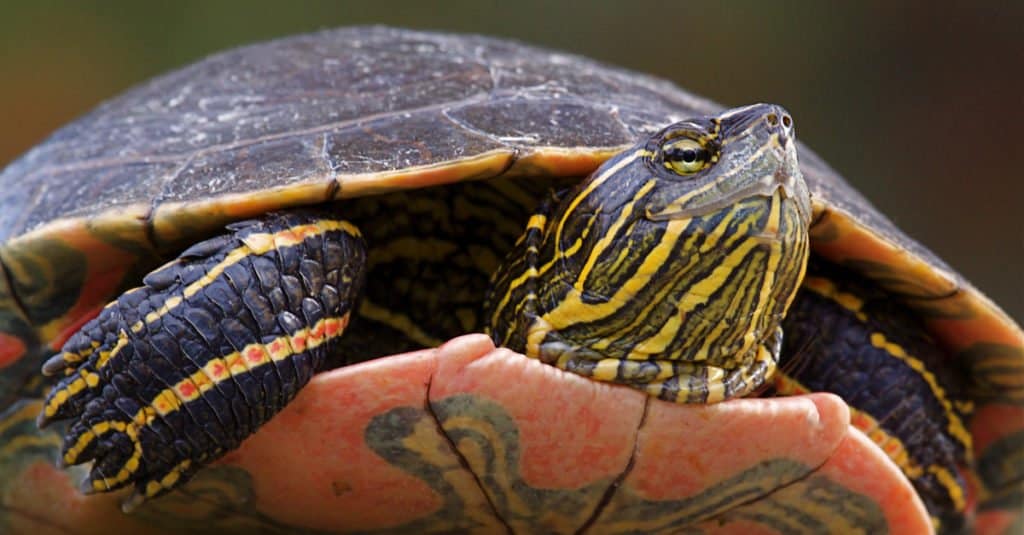
These turtles are 4 to 10 inches long with vibrant red and yellow markings on their shells, limbs, and heads.
©Tom Reichner/Shutterstock.com
It was not until 1995 that Michigan designated a state reptile, thanks to the lobbying of fifth graders from the city of Niles. Michigan’s official state reptile, the painted turtle (Chysemys picta), is common throughout the state. It is also one of the most recognizable turtles in all of Michigan. These turtles are 4 to 10 inches long with vibrant red and yellow markings on their shells, limbs, and heads. They prefer living in shallow and slow-moving bodies of water, like ponds, marshes with muddy bottoms, lakes, and streams with sandy bottoms.
Painted turtles spend most of their time either in the water or near it, and eat insects, mollusks, crayfish, and pond vegetation. They do not have any teeth, but their strong jaws have horny plates that are good for gripping their food. During the winter, painted turtles bury themselves in the mud and hibernate, keeping themselves safe from Michigan’s bitter cold.
4. State Game Mammal: White-Tailed Deer (Odocoileus virginianus)
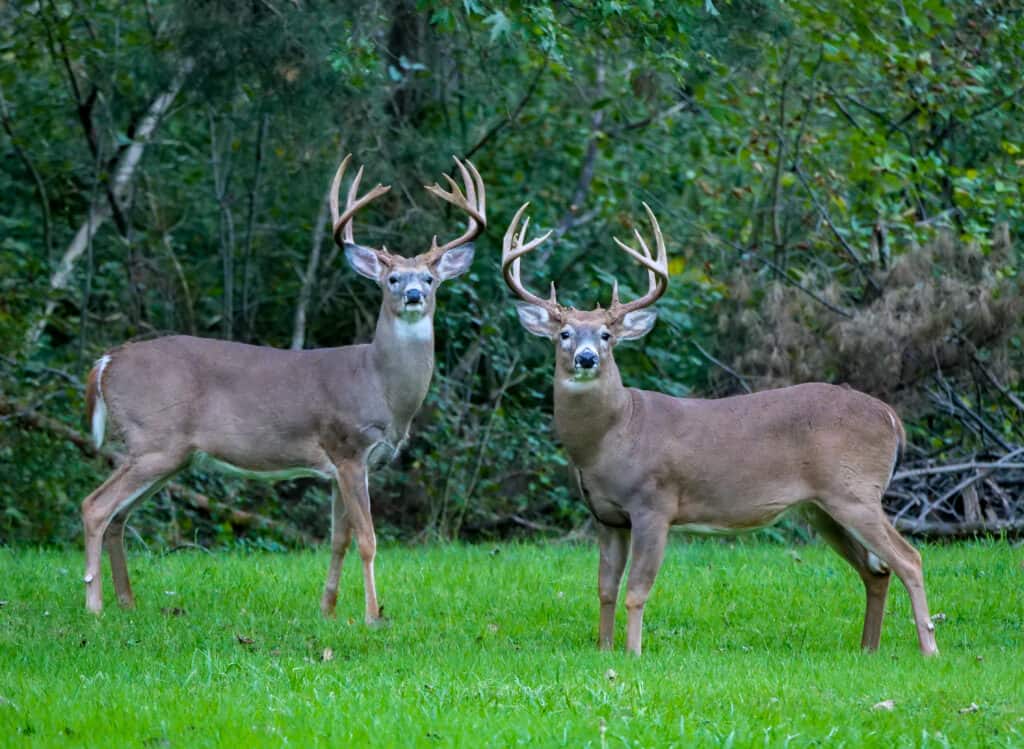
Their athleticism is one of the reasons that white-tailed deer are so common in Michigan. They can easily jump over fences!
©iStock.com/Ralph Navarro
Fourth graders from Zeeland, Michigan, helped to make the white-tailed deer (Odocoileus virginianus) the official state game mammal in 1997. White-tailed deer are found in every county in Michigan and are also one of the most popular game animals for hunting in the state. They can run 35 to 40 miles per hour, jump over 9-foot fences, and even swim 13 miles per hour! Their athleticism is one of the reasons that white-tailed deer are so common in Michigan, as they live in fields, forests, and even in urban neighborhoods where they can easily jump over fences.
Although they have excellent eyesight, white-tailed deer are partially colorblind. When a white-tailed deer is in danger, it waves its small tail, exposing the white fur as a warning to other deer and animals in the area. Deer eat a wide variety of different plants, fruit, and nuts, and give birth to baby fawns in May and June.
5. State Fossil: Mastodon (Mammut americanum)
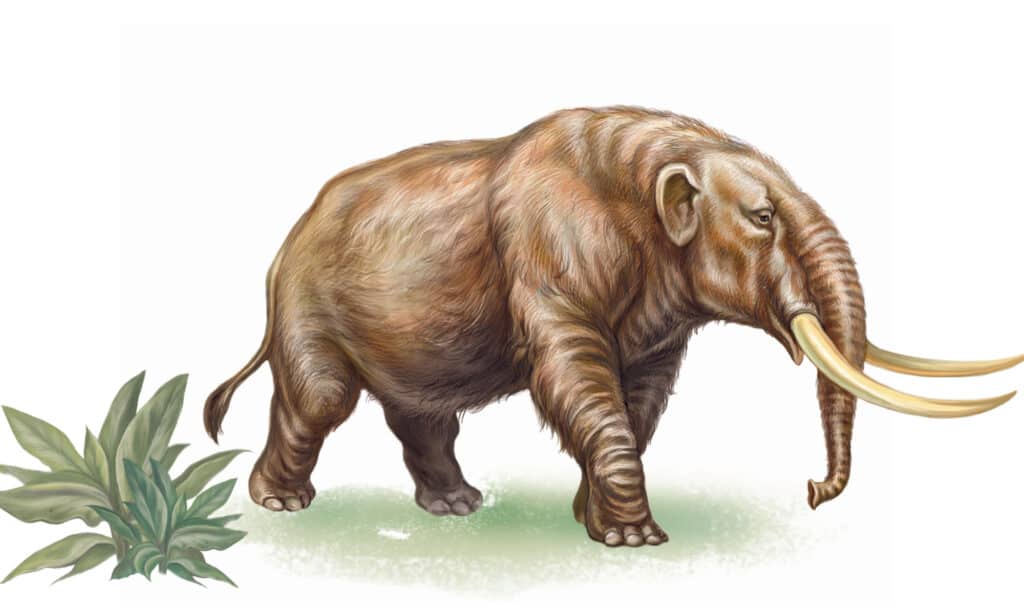
Mastodons are extinct mammals that once lived throughout the state of Michigan, as recently as 10,000 years ago.
©Liliya Butenko/Shutterstock.com
The most recent official state animal of Michigan is the mastodon (Mammut americanum), Michigan’s official state fossil. David P. Thomas, a professor of geology at Washtenaw Community College, led a campaign for Michigan to adopt the mastodon, holding petition drives, winning support from students and teachers, and attending many meetings and hearings. In 2002, Thomas’ efforts paid off, and Michigan declared the mastodon as the official state fossil.
Mastodons are extinct mammals that once lived throughout the state of Michigan, as recently as 10,000 years ago. Although they were somewhat similar to woolly mammoths and today’s elephants, mastodons had straighter tusks and different body shapes. One of the most complete mastodon skeletons ever found was discovered in Owosso, Michigan. It is now on display at the University of Michigan Museum of Natural History. In addition, there are 30 mastodon footprints just outside of Ann Arbor. This is the most complete, intact, and longest trail of mastodon footprints ever discovered.
Honorable Mention: Wolverine (Gulo gulo)
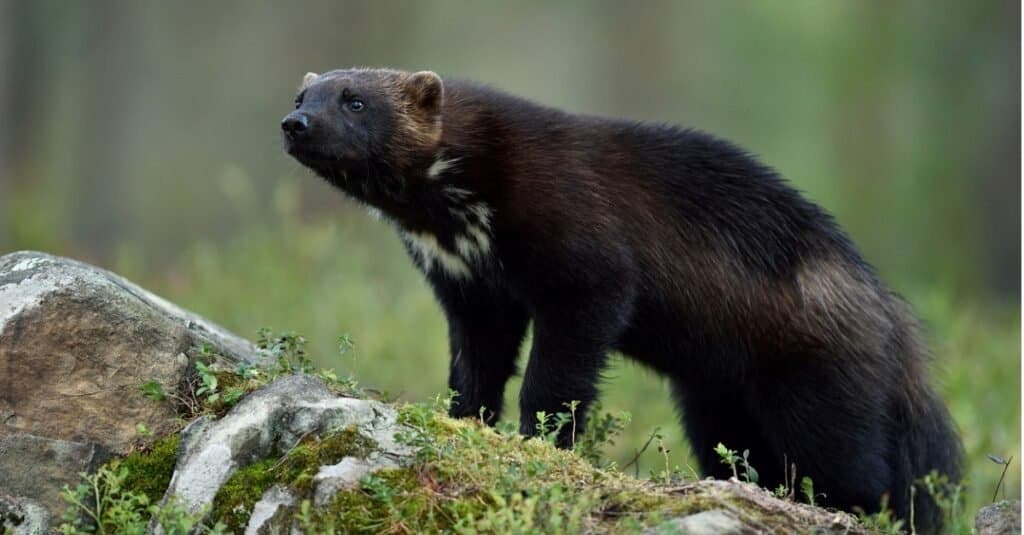
Wolverines are surprisingly strong for their size and can easily hunt and take down prey much larger than themselves!
©iStock.com/ErikMandre
Michigan is known as the “Wolverine State”, and Michiganians are often called “wolverines.” Wolverines are medium-sized mammals that live in the northern regions of Europe, North America, and Asia. They have long bodies that are low to the ground and thick, dark brown fur with lighter-colored markings. Adults typically weigh 18 to 40 pounds and are known to be powerful and ferocious creatures. Wolverines are surprisingly strong for their size and can easily hunt and take down prey much larger than themselves!
However, there are no wolverines in Michigan, nor any evidence of these animals ever living here! So, then why is Michigan called the “Wolverine State”? There are several theories, although no one really knows for sure. Some believe that when European settlers moved into Michigan in the 1830s, Native Americans referred to them as “wolverines” because they saw them as gluttonous and aggressive.
Others believe that the nickname came from early fur trappers who hunted wolverines. For generations, the trading post at Sault Ste. Marie in Michigan was a vital hub of commerce between Native Americans and trappers, exchanging a variety of goods — including prized wolverine pelts from Canada. It’s thought that these furs were labeled “Michigan Wolverines” due to their origin at this trading post.
However, the most accepted theory is that during the conflict over the Ohio-Michigan border, the people of Ohio called Michigians “wolverines” due to their fierceness and aggressiveness. Although this was meant as an insult, Michiganians took pride in the title, and the University of Michigan even adopted the Wolverine as its school mascot.
Official State Animals of Michigan
| Official Title | Common Name | Scientific Name |
|---|---|---|
| State Bird | American Robin | Turdus migratorius |
| State Fish | Brook Trout | Salvelinus fontinalis |
| State Reptile | Painted Turtle | Chysemys picta |
| State Game Mammal | White-Tailed Deer | Odocoileus virginianus |
| State Fossil | Mastodon | Mammut americanum |
| Honorary State Nickname | The Wolverine State | Wolverine (Gulo gulo) |
Other Official State Symbols in Michigan
In addition to the official state animals of Michigan, the state is also home to a wide range of other natural symbols, from trees to flowers, soil, and fruit:
| Official Title | Common Name | Scientific Name |
|---|---|---|
| State Flower | Apple blossom | Pyrus coronaria |
| State Tree | White pine | Pinus strobus |
| State Stone | Petoskey stone | Hexagonaria percarinata |
| State Gem | Chlorastrolite | N/A |
| State Soil | Kalkaska soil series | N/A |
| State Wildflower | Dwarf lake iris | Iris lacustris |
The photo featured at the top of this post is © KARI K/Shutterstock.com
FAQs (Frequently Asked Questions)
What is the official state animal of Michigan?
The official state animal of Michigan is the white-tailed deer (Odocoileus virginianus).
How does an animal become an official state symbol of Michigan?
Michigan takes great pride in its selection of official state symbols, and any proposed additions must go through a rigorous process of approval from both the legislative process and the current governor. This process ensures only the most deserving icons are recognized as symbols of the renowned state of Michigan.
Why is Michigan called the "Wolverine State"?
There is no evidence that wolverines have ever lived in Michigan, and yet it is called the “Wolverine State”. No one really knows how this nickname came to be, but there are many theories. Some believe that Native Americans called European settlers wolverines because they came in and ate up the land.
Others think that it came from Michigan’s trading post at Sault Ste. Marie. Fur traders often bartered with wolverine pelts, so wolverines may have become associated with the state.
However, most believe that the nickname came about during the “Toledo War” when Ohio and Michigan were fighting over the border between them. People in Ohio were thought to have called Michiganians wolverines as an insult. However, it is now a source of pride. Even the mascot for the University of Michigan is a wolverine!
What are Michigan's other state symbols?
Michigan has 12 official state symbols, including:
- State Bird: American robin (Turdus migratorius)
- State Fish: Brook trout (Salvelinus fontinalis)
- State Game Mammal: White-tailed deer (Odocoileus virginianus)
- State Fossil: Mastodon (Mammut americanum)
- State Reptile: Painted turtle (Chysemys picta)
- State Flower: Apple blossom (Pyrus coronaria)
- State Tree: White pine (Pinus strobus)
- State Stone: Petoskey stone (Hexagonaria percarinata)
- State Gem: Chlorastrolite (literally “green star stone”)
- State Soil: Kalkaska soil series
- State Wildflower: Dwarf lake iris (Iris lacustris)
- State Song: “My Michigan”, written by Giles Kavanagh and H. O’Reilly Clint in 1933.
Thank you for reading! Have some feedback for us? Contact the AZ Animals editorial team.






